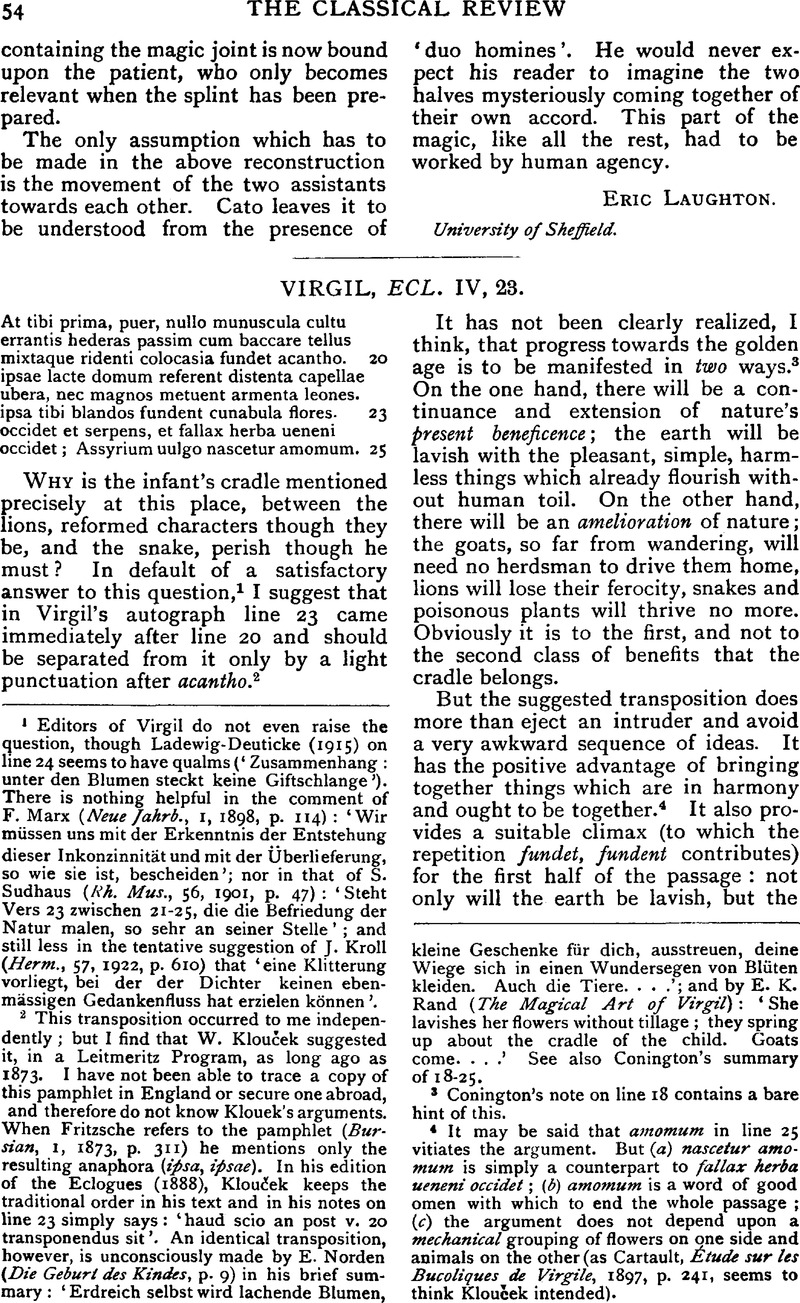No CrossRef data available.
Article contents
Virgil, Ecl. IV, 23
Published online by Cambridge University Press: 27 October 2009
Abstract

- Type
- Review Article
- Information
- Copyright
- Copyright © The Classical Association 1938
References
page 54 note 1 Editors of Virgil do not even raise the question, though Ladewig-Deuticke (1915) on line 24 seems to have qualms (’Zusammenhang: unter den Blumen steckt keine Giftschlange’). There is nothing helpful in the comment of Marx, F. (Neue fahrb., 1, 1898, p. 114):Google Scholar ‘Wir müssen uns mit der Erkenntnis der Entstehung dieser Inkonzinnität und mit der Überlieferung, so wie sie ist, bescheiden’; nor in that of Sudhaus, S. (Rh. Mus., 56, 1901, p. 47):Google Scholar ‘Steht Vers 23 zwischen 21—25, die die Befriedung der Natur malen, so sehr an seiner Stelle’; and still less in the tentative suggestion of Kroll, J. (Herm., 57, 1922, p. 610) that ‘eine Klitterung vorliegt, bei der der Dichter keinen ebenmässigen Gedankenfluss hat erzielen kännen’.Google Scholar
page 54 note 2 This transposition occurred to me independently; but I find that W. Kloucek suggested it, in a Leitmeritz Program, as long ago as 1873. I have not been able to trace a copy of this pamphlet in England or secure one abroad, and therefore do not know Klouek's arguments. When Fritzsche refers to the pamphlet (Bursian, 1, 1873, p. 311)Google Scholar he mentions only the resulting anaphora (ipsa, ipsae). In his edition of the Eclogues (1888), Klouček keeps the traditional order in his text and in his notes on line 23 simply says: ‘haud scio an post v. 20 transponendus sit’. An identical transposition, however, is unconsciously made by Norden, E. (Die Geburl des Kindes, p. 9) in his brief summary:Google Scholar ‘Erdreich selbst wird lachende Blumen, kleine Geschenke für dich, ausstreuen, deine Wiege sich in einen Wundersegen von Blüten kleiden. Auch die Tiere.…’; and by E. K. Rand (The Magical Art of Virgil): ‘She lavishes her flowers without tillage; they spring up about the cradle of the child. Goats come.…’ See also Conington's summary of 18–25.
page 54 note 3 Conington's note on line 18 contains a bare hint of this.
page 54 note 4 It may be said that amomum in line 25 vitiates the argument. But (a) nascetur amomum is simply a counterpart to fallax herba ueneni occidet; (b) amomum is a word of good omen with which to end the whole passage; (c) the argument does not depend upon a mechanical grouping of flowers on one side and animals on the other (as Cartault, Etude sur les Bucoliques de Virgile, 1897, p. 241, seems to think KlouČek intended).Google Scholar
page 55 note 1 Commentators do not help us to understand the precise relation between the cunabula and the flores. In his translation (Virgiľs Messianic Eclogue, p. 5) Conway, R. S. speaks of ‘thy cradle blossoming for joy’Google Scholar; but later (p. 40) of ‘the magical flowers beside the cradle’. Conington in his note says: ‘The ground on which thou liest will of its own accord bring forth flowers’. No parallel is cited from ancient literature for a sprouting cradle.
page 55 note 2 A poet of Virgil's quality expounds a general theme by particulars which have a special propriety. So the items of the second group are not selected without regard to the child. As Servius naïvely remarks, milk is good for babies: its bounteous supply (cf. distenta) is secured by the willing co-operation of the shegoats and the immunity of the cattle from attacks by lions; the snake is an evil which the child is not yet old enough to avoid for himself, and the poison-plant he cannot yet distinguish from the flowers amidst which it might be growing.
page 55 note 3 Cf. Professor Mountford's n. 1 on this page.
page 56 note 1 The verdure of Hor. carm. Ill iv 9–20 is camouflage, not a coverlet.
page 56 note 2 It could only be escaped by understanding ‘that very-parl-of-the-earth which constitutes your (temporary) cradle’; and if there is anybody who really wants to do that, it would probably be wisest to humour him.
page 56 note 3 In agreement, I am glad to find, with M. see above.




